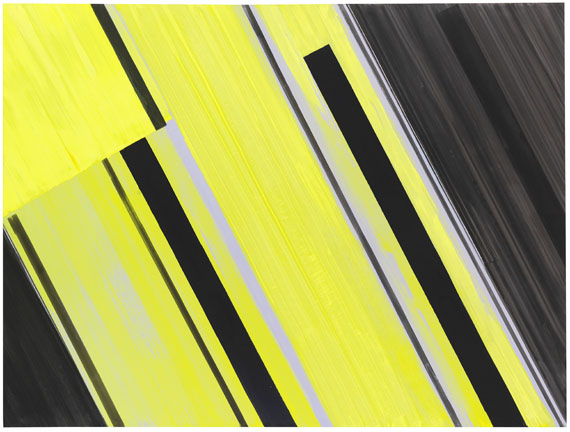Dictionary


Concrete Art 1945-1960
After Theo van Doesburg set out the basic principles of Concrete Art in the Art Concret journal (1930) the development of concrete art, between 1945 and 1960 in particular, was characterised by a gradual systematisation of its formal language. The order inherent to the work, gained increasing importance. This process provided the conditions for Op Art (whose key exponent was Bridget Riley (born 1931)), and could be formally distinguished by a pictorial space, which was increasingly, evenly filled with serially produced small forms, evoking a feeling of dynamism and movement in the observer. One of the key basic theoretical demands of Concrete Art was to replace abstraction of the material world, with an independent reality within the painting. Key exponents of Concrete Art post-1945, included Julio Le Parc, François Morellet, Gerhard von Graevenitz and Richard Paul Lohse. Other less central artists included Richard Paul Lohse (1902-88), Max Bill and Camille Graeser, who were part of the Zurich concretists movement, which emerged in the 1930s and continued to be active post-1945. Max Bill (1908-94) articulated his structural requirements of Concrete Art in the essay "The Mathematical Modes of Thought in the art of our time" (1949), and between 1944 and 1945, published the journal "abstrakt konkret". Two exhibitions which had a significant impact on the establishing of Concrete art were "konkrete kunst" (Basel 1944) organised by Max Bill, and "konkrete kunst. 50 jahre entwicklung" (Concrete Art – 50 Years of Development). The Moviemento Arte Concrete pioneered concrete Art in Italy.
On the other side of this development, was the work of Josef Albers (1888-1976), (who emigrated to the USA in 1933) which had a key position within Concrete Art. In his later works, he took to completion a variation of a square in technically precise format, with the highest focus on concentrated, visual mediums of form and colour.
After Theo van Doesburg set out the basic principles of Concrete Art in the Art Concret journal (1930) the development of concrete art, between 1945 and 1960 in particular, was characterised by a gradual systematisation of its formal language. The order inherent to the work, gained increasing importance. This process provided the conditions for Op Art (whose key exponent was Bridget Riley (born 1931)), and could be formally distinguished by a pictorial space, which was increasingly, evenly filled with serially produced small forms, evoking a feeling of dynamism and movement in the observer. One of the key basic theoretical demands of Concrete Art was to replace abstraction of the material world, with an independent reality within the painting. Key exponents of Concrete Art post-1945, included Julio Le Parc, François Morellet, Gerhard von Graevenitz and Richard Paul Lohse. Other less central artists included Richard Paul Lohse (1902-88), Max Bill and Camille Graeser, who were part of the Zurich concretists movement, which emerged in the 1930s and continued to be active post-1945. Max Bill (1908-94) articulated his structural requirements of Concrete Art in the essay "The Mathematical Modes of Thought in the art of our time" (1949), and between 1944 and 1945, published the journal "abstrakt konkret". Two exhibitions which had a significant impact on the establishing of Concrete art were "konkrete kunst" (Basel 1944) organised by Max Bill, and "konkrete kunst. 50 jahre entwicklung" (Concrete Art – 50 Years of Development). The Moviemento Arte Concrete pioneered concrete Art in Italy.
On the other side of this development, was the work of Josef Albers (1888-1976), (who emigrated to the USA in 1933) which had a key position within Concrete Art. In his later works, he took to completion a variation of a square in technically precise format, with the highest focus on concentrated, visual mediums of form and colour.
Offers
Headquarters
Joseph-Wild-Str. 18
81829 Munich
Phone: +49 89 55 244-0
Fax: +49 89 55 244-177
info@kettererkunst.de
Louisa von Saucken / Undine Schleifer
Holstenwall 5
20355 Hamburg
Phone: +49 40 37 49 61-0
Fax: +49 40 37 49 61-66
infohamburg@kettererkunst.de
Dr. Simone Wiechers / Nane Schlage
Fasanenstr. 70
10719 Berlin
Phone: +49 30 88 67 53-63
Fax: +49 30 88 67 56-43
infoberlin@kettererkunst.de
Cordula Lichtenberg
Gertrudenstraße 24-28
50667 Cologne
Phone: +49 221 510 908-15
infokoeln@kettererkunst.de
Hessen
Rhineland-Palatinate
Miriam Heß
Phone: +49 62 21 58 80-038
Fax: +49 62 21 58 80-595
infoheidelberg@kettererkunst.de
We will inform you in time.




